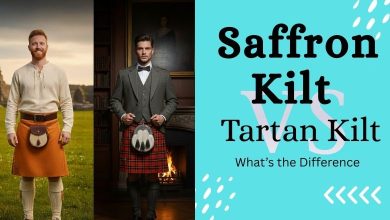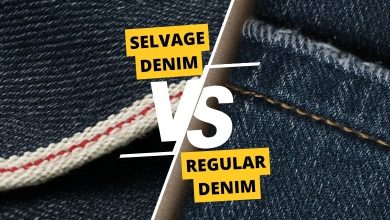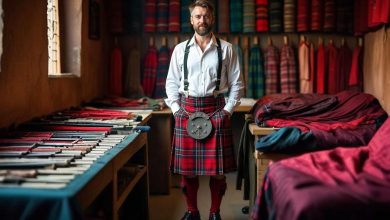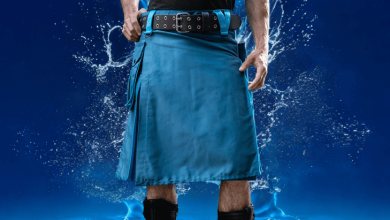Traditional Scottish Clothing – Guide to Traditional Scottish
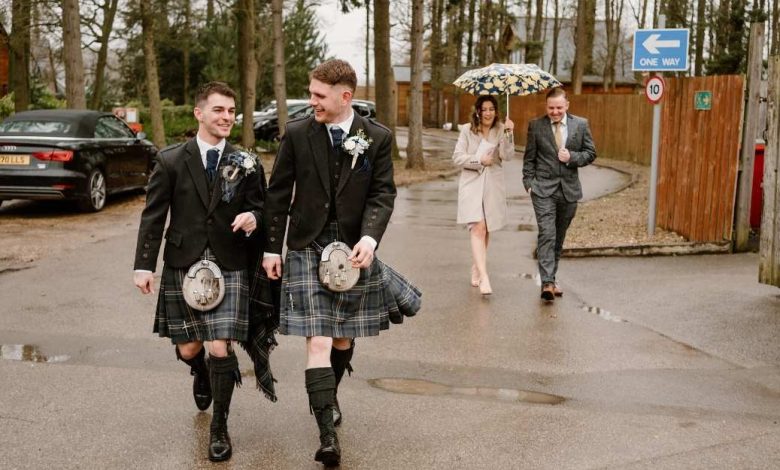
Usually clothes are famous because of their area of origin. Do you know there is a specific attire that has added to a country’s fame? You got it; we are talking about traditional Scottish clothing.
The history of these attires is vast since they have been around for over 40 decades. Moreover, they have spread their roots to different parts of the world, including the USA, Spain, France, Canada, etc.
Despite its mysterious history, this attire is essential for Scots, even in current times. It has faced many variations, and its grace has captivated people’s attention. Our focal point today is this particular Scottish attire. So, let us start with the introduction!
What Is Traditional Scottish Clothing?
Are you fond of Scottish culture? If yes, you must have noted participants playing their part in similar skirt-like dresses in Highland games or people wearing the same at different events. Have you? This similar dress is their traditional one and has cultivated roots over centuries.
Attires have different accessories. You know what? These clothing’s witnessed multiple variations from the moment of invention to the present. All of this will be discussed after having an overview of their significance.
The Significance
The presence of a culture for a long time reveals how important it is. The same is true of this ancient clothing. However, the Scots have played an exceptional part in keeping their culture alive and spreading it to other parts of the Earth.
The Scots living in Scotland and other countries also respect and honour their outfit by wearing it at weddings, graduation ceremonies, funerals, special events, etc.
Another fact that proves their significance is that people are still working on it and are excited to know about its history. On the other hand, new designs are being introduced with time favoring their significance and demand as well.
Historical Variations
Before we discuss the historical variations of Scottish traditional clothing, let us look at its basic past. Introduced at the start of the mid-16th century, it was initially made for warriors.
That was an era of Scottish clans, and every clan had a specific identical pattern. It was known as tartan then. When the era of wars came to an end, sportsmen and other people started wearing them and it continues. Here are some historical variations of these attires that they adopted with time.
Primarily, we see two variations in kilts: the Great Kilt and the Modern Kilt. While exploring deeply, we usually see many kilts that are parts of modern kilts, such as utility kilts, sports kilts, fashion kilts, etc.
Great Kilt
The next variation of traditional Scottish attire was the Great Kilt. Its specifications were identical to modern ones, but some features set it apart. Great kilts were also made of cotton wool but were quite durable and had a long upper part. People also used to wear it at the upper part as cloaks and blankets.
In the 18th century, the great kilts witnessed a revolution and became proper attire. People then used them for both casual and special events. They remained the same until the century ended and were later transformed into the modern ones.
Tartan
The Scottish traditional clothing was usually made of tartan. It had a specific pattern with intersecting lines, and they were hand-woven. Every clan or sept had a unique tartan, and no other tribe was allowed to use the same pattern.
At present, Scots still follow their clan system and wear the tartan used by their ancestors. Only 20% of Scots know their specific traditional tartan kilt. The rest of the people are still exploring their family tartans using tartan databases and family trees. However, all the people there are allowed to wear these clothes.
Modern Kilt
The Scottish outfits people wear today are the modern ones. In other words, traditional Scottish clothing has been substituted with modern kilts. Time transformed its shapes, but the initial purpose of comfort and unrestricted movement remained the same.
The history of modern kilts is impressive. Before the 18th century only men used to wear kilts. Women started wearing this classical outfit in the 19th century in dancing competitions.
Anatomy Of Scottish Attires
The majority think that Scottish attire has remained the same throughout history. The truth strongly opposes this. The first variants were relatively simple and had few accessories. However, the attires we see or wear today are well-designed and more streamlined. Here is a list of Scottish traditional clothing parts and their basic descriptions.
Kilt
Kilts are skirt-like clothing usually worn by men. They are of the knee length and are generally made of cotton or tartan fabric. The back of the kilt has pleats to provide comfort while moving.
Kilt shirt
Kilts cover the lower part of bodies. Kilt shirts are usually made with a heavier fabric than the standard shirt covering the upper part of the body. Their way of wearing differs from other shirts since they are designed to be worn with sash.
Kilt Jacket
A kilt jacket is one of the most important parts of Scottish attire. It usually admires the tartan and kilt. A positive aspect of these jackets is their availability in different styles featuring different traits.
Fly Plaid
You might have seen Scottish people having a specific piece of cloth on their shoulders. This is a fly plaid. Kilt jackets usually have a strap to hold the fly plaid.
Kilt Pins
Next on the list of parts is kilt pins! It comprises pins in different styles representing any clan.
Kilt Hat
It is another part of the traditional dress of Scots. It is a cap that comprises a loose band, a ribbon, and a crown. People also know the headgear as a tartan hat. Its history is as old as the kilts. This hat has some other names like Tam O’Shanter and the Glengarry.
Waistband
Do you know what a waistband is? It is the upper part of the kilt surrounding your body. Tartan fabric is often used in its formation.
Buckles And Straps
Scot attires have buckles and straps to hold them. Straps usually made of leather. They generally have three straps, two on the one side and one on the other side, to fasten together.
Pleats
Pleats are their essential parts. They are flexible foldings on the backside of kilts that help in easy movement. Pleats have variations, such as box, knife, and military pleats that are different in shapes.
Sporrans
The sporrans are an essential part of traditional Scottish attire made of fur or leather. Outfits in the past did not have pockets like modern kilts. So, people tied sporrans to their attires to keep their precious items.
Hose
Scots wear long socks with different patterns reaching the knees. They are cotton-made and quite soft. These socks are the hose.
Ghillie brogues
The Scots, when wearing their classical attire, are seen with special leather shoes and laces tied with ankles. These shoes have some unique-style holes on the toe cap and sides called brogues. The entire article is known as Ghillie brogues. Scottish attire is considered complete with them.
The Facts
- The word kilt is derived from the ancient Norse word “kilts”, which means the pleats.
- The actual history of the Scottish traditional dress is still unknown. Some studies reveal the first record was in 1538.
- In the initial days, kilts were available in a few color’s: white, brown, green, and black.
- Only men used to wear kilts in history.
- Women started wearing kilts as dancing dresses at the end of the 18th century.
Conclusion
The Scots have respect for their traditions like the other nations. Some of their traditions, like Highland Games, are still a permanent part of their lives. Likewise,
traditional Scottish clothing is also important, strongly representing their culture. The attire comprise historical variations like tartan, the great kilt, and the modern kilt. When it comes to their parts or anatomy, they have many parts, from kilts to Ghillie brogues. Traditional Scottish Clothing – Guide to Traditional Scottish
